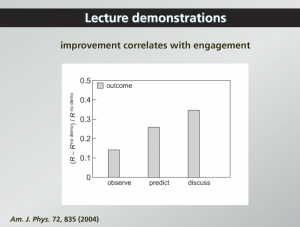Eric Mazur stands out in the crowd. His keynote at the 2012 ALT-C created a dip, some may argue a black hole. And I wasn’t even in the audience (I was watching from home).
You will say I exaggerate. But think about it: how many professors teaching in large lecture rooms have nearly single-handedly turned the wide belief that lectures have to be teacher-centred on its head?
Not many. The idea that interactivity promotes engagement and therefore assimilation of knowledge is well known but usually reserved to tutorials and labs in Higher Education, reportedly because of logistics (‘I have too many students’, ‘there are tutorials for this’, and so on). Although these arguments are not to be overlooked, Mazur proves that it can be done when your mind is set to it.
If you have never heard of Professor Eric Mazur, lose no time, watch this short two-minute video first:
So why is it so hard to detach oneself from the traditional approach?
Well, for one thing, as Mazur points out, we tend to replicate the way we have been taught. It’s natural, it worked for you, why would it not work for your students. It is particularly hard to detach oneself from the traditional approach, even when familiar with the concept of varying learning styles.
Secondly, we tend to focus on the content we need to teach, rather than the learning experience. It’s hard not to when, as a lecturer, you have so much knowledge (in comparison to your students, that is) to transmit.
Thirdly, we forget, as teachers, what the learning journey is like- what it was like to have to construct meaning out of brand new concepts, especially when these were understood a long time ago.
Mazur’s keynote take-away
Here are my take-away points, chewed on and digested:
1. We’re not here so much to teach but to enable students to learn.
2. Learning means understanding and assimilating, so that this can be used in a variety of contexts; teaching is not simply presenting knowledge.
3. Teaching should focus on the student, not the knowledge content.
How do these three take-away points come out of Mazur’s presentation? Well, I won’t tell you in details because I would really like you to watch his presentation, but let me give you a summary here:
The first of three parts focused on gender issues and how environment appears to affect our understanding of a problem. Mazur has collected data indicating that interactive engagement and teaching by questioning reduces the gap between genders. Looking at ways to cater for a variety of learning styles or approaches can be reduced by simple steps: make your students think their way through a problem.
The second part of the presentation was on how lecture demonstrations can be a poor learning tool if devoid of engagement from students in the form of a discussion or other activity.
The third and final part presented the idea that confusion is not necessarily a bad learning experience for a student to be going through- so long as an effort to resolve it takes place.
This last point is interesting as we focus so much on delivering clear lectures, Mazur explains, but making your way through difficult content means being active in one’s learning- particularly potent when you look at how active the brain is during a class (not very), as illustrated in this surprising graph visualising data as presented by Mazur (ALT-C 2012 keynote):
 Placing students in a situation where they have to figure out their journey from A to B is of course how you place them in a situation where they need to gain a (deep) understanding of what is at stake. Regurgitating knowledge without really understanding it will be worthless as it cannot be reused, as we all know.
Placing students in a situation where they have to figure out their journey from A to B is of course how you place them in a situation where they need to gain a (deep) understanding of what is at stake. Regurgitating knowledge without really understanding it will be worthless as it cannot be reused, as we all know.
So why do summative tests focus so much on results, Mazur wonders, pointing out that they may be the ‘silent killer’ of the assessment process. And there are of course a lot of talk around this area at the moment…
Final word
Oddly enough Mazur’s keynote only contained one short reference to technology (‘clickers’). You may find this odd considering that this is the biggest Learning Technology event of the year (in Britain). But I find this really interesting: a gentle reminder that technologies are here to support teaching strategies, not the other way around, and that the adoption of just one technology can make such a difference to your teaching delivery.
[You may watch this hour-long keynote shortly here – worth your while – or listen to this hour-long interview in the meantime:�http://tinyurl.com/8ah899s]

Pingback: The science of teaching « Jenny Connected
Pingback: Oxford Centre for Staff and Learning Development » Bookmarks for September 12th through September 17th